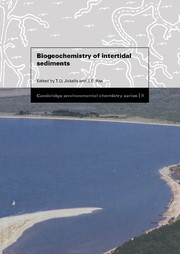Book contents
- Frontmatter
- Contents
- List of contributors
- Preface
- 1 Biogeochemistry of intertidal sediments
- 2 Trace metals in deposited intertidal sediments
- 3 Modelling adsorption and desorption processes in estuaries
- 4 A critical appraisal of the methodology used in studies of material flux between saltmarshes and coastal waters
- 5 Nutrient recycling in intertidal sediments
- 6 An overview of carbon and sulphur cycling in marine sediments
- 7 Microbial activity and diagenesis in saltmarsh sediments, North Norfolk, England
- 8 The behaviour of radionuclides in the coastal and estuarine environments of the Irish Sea
- 9 The sorption of hydrophobic pyrethroid insecticides to estuarine particles: a compilation of recent research
- Index
1 - Biogeochemistry of intertidal sediments
Published online by Cambridge University Press: 23 September 2009
- Frontmatter
- Contents
- List of contributors
- Preface
- 1 Biogeochemistry of intertidal sediments
- 2 Trace metals in deposited intertidal sediments
- 3 Modelling adsorption and desorption processes in estuaries
- 4 A critical appraisal of the methodology used in studies of material flux between saltmarshes and coastal waters
- 5 Nutrient recycling in intertidal sediments
- 6 An overview of carbon and sulphur cycling in marine sediments
- 7 Microbial activity and diagenesis in saltmarsh sediments, North Norfolk, England
- 8 The behaviour of radionuclides in the coastal and estuarine environments of the Irish Sea
- 9 The sorption of hydrophobic pyrethroid insecticides to estuarine particles: a compilation of recent research
- Index
Summary
In some places the boundary between land and sea is in the form of abrupt and often spectacular cliffs but, elsewhere, the boundary can take the form of a complex environment of intertidal sediments. These environments include shingle banks, sandy beaches, mud flats, saltmarsh and mangrove (or mangal) communities. In some cases one or other of these environments will occur, in others they will be associated with one another. For example, on many North Sea and North American East Coast shorelines, mud flats grade into saltmarshes behind the shelter of shingle spits and sand dunes. In general, saltmarshes and mangroves occupy similar ecological niches with mangroves at lower latitudes (winter temperatures greater than 10°C) and saltmarshes at high latitudes, though in some locations both communities coexist (Chapman, 1977).
The considerable global significance of these intertidal systems is evident from Figure 1.1. Around the coast of Britain alone there are 44 370 hectares (ha) of saltmarsh (Allen & Pye, 1992) and 589 429 ha on the US East Coast (Reimold, 1977) with a total global area of 3.8 × 107ha (Steudler & Peterson, 1984 and references therein). There are 365 500 ha of mangal forest around the Indian subcontinent and another 250 000 ha in the Mekong delta (Blasco, 1977). The total global area of mangal is about 2.4 × 107ha (Twilley, Chen & Hargis, 1992).
- Type
- Chapter
- Information
- Biogeochemistry of Intertidal Sediments , pp. 1 - 15Publisher: Cambridge University PressPrint publication year: 1997
- 5
- Cited by



